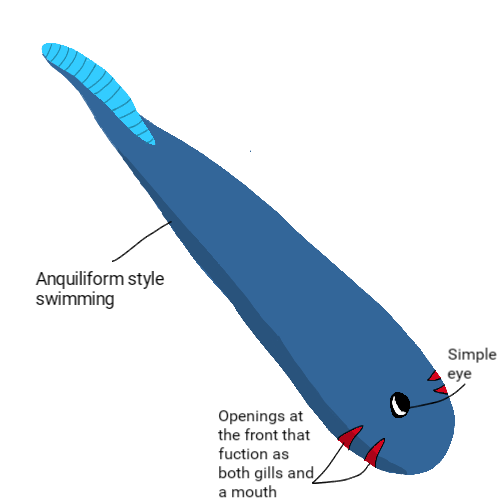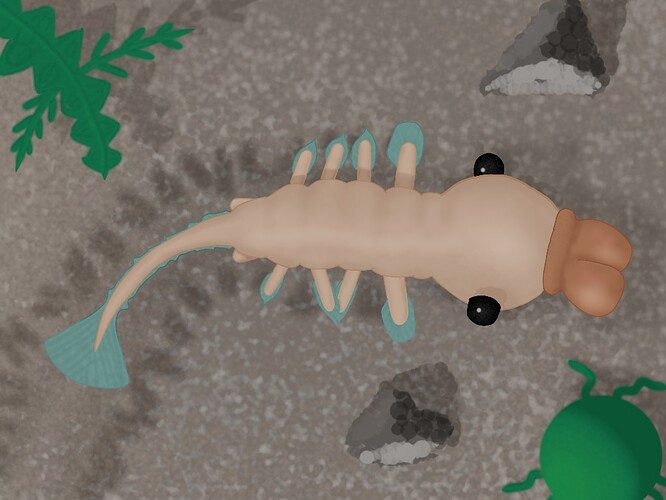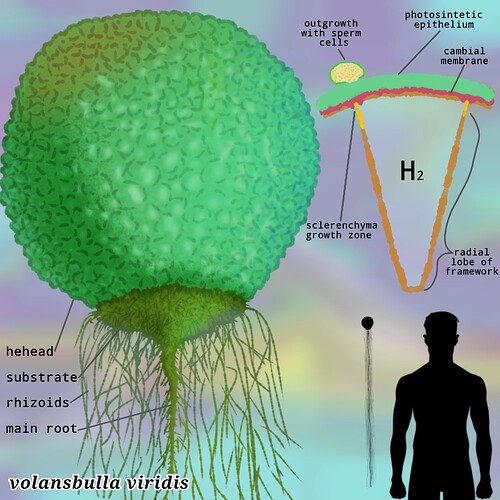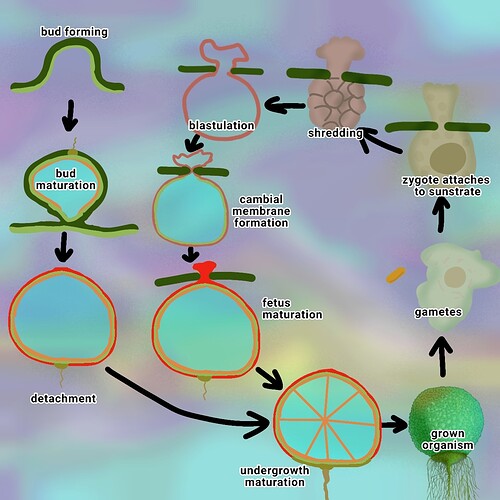Welcome to the forums!
Hello! Welcome to the forums!
Ideas
Gass giant creatures
Floating moss
A large balloon like filter feeder
Leeches that can expand into balloons to find a new host
Carnivorous pterodactyls perched on living balloon
Sea creatures
Sea porcupines
Eldritch horrors
6 finned fish
Life on Titan
Plants that have natural mirrors attached to them to get enough light.
Animals that have shells made of ice.
Instead of having a large surface area mirror and directing the light to a small surface area leaf, they can just have a large surface area leaf
Volansbullae is a family of xenoplants whose representatives, namely volansbulla viridis, were the first described multicellular life of the gas giant Castor l. Extremely diverse, there are both tiny species with a diameter of 3 millimeters, and giants growing up to 30 meters and accommodating a whole ecosystem of other organisms. They are an important food resource for local life and one of the most common groups of organisms.
Structure
The volansbullae organism consists of two parts - the head and the rhizome. The first is a ball, covered on the outside with photosynthetic tissue, on the inside - with a framework of sclerenchyma (dead and hardened tissue) and a cambial film in the middle. This framework consists of several tens of radial lobes and acts as a reservoir for the accumulation of hydrogen to maintain buoyancy.
The cambial membrane is responsible for the growth of the sclerenhimal framework, maintaining tightness and controlling the level of hydrogen in it. When the illumination decreases or overheat, it begins to release hydrogen for raising up, and when the permissible illumination or hypothermia is exceeded, it begins to bind it for lowering down.
The rhizome consists of cells incapable of photosynthesis, all the nutrients that are received through the vessels from the head. It includes a substrate that attaches the rhizome to the head, the main root, due to the weight of which the plant maintains a stable position in the air, and rhizoids - long outgrowths of cells covered with mucus to trap, dissolve and absorb the smallest particles of minerals, the salts of which are necessary for the plant to grow. Nutrients are also stored in the substrate and the main root. The plant receives water through the absorbing pairs of hairs located over the entire surface of the body.
Reproduction
Volansbullae reproduce in two ways: sexually and vegetatively. During vegetative propagation, a process is formed that captures the photosynthetic tissue and part of the cambial membrane. In the resulting kidney, active cell division and hydrogen synthesis occur, as well as the growth of sclerenchyma. After a short growth, a rhizoid is laid in the apical cell, the cell will further grow into a substrate, and the rhizoid will turn into the main root. At this stage, the bud detaches and floats freely.
The reasons for the beginning of the active release of spermatozoa are not yet fully understood, probably, the illumination and the strength of the wind can serve as the reason. Spermatogenesis occurs in special outgrowths of the photosynthetic epithelium of the head. It is noteworthy that before the exchange of DNA segments between sister chromosomes (crossing over), there is no doubling of chromosomes, which is why only 2, not 4 sperm are obtained from one precursor cell. After ejection, the sperm cells, endowed with hydrogen vacuoles, are dispersed over a vast area (about 1 million square kilometers) in the hope of eventually attaching to the mucous cover of the rhizoids of another plant for further fertilization.
Female gametes are formed from the cells of the epithelium of the substrate. Only a young cell without a rhizoid can become an egg. In this process, it crosses over, dissolves its cell wall, acquires a developed cytoskeleton, and begins to resemble an amoeba. It is noteworthy that the polar body is not formed, and unnecessary chromosomes are dissolved by the digestive vacuole. In the resting stage, it saves energy by periodically feeding on epithelial cells. When the sperm is attached to the rhizoid, the egg begins to actively move in its direction, and when they meet, fertilization occurs.
(Interesting fact: there is a disease in which uncontrolled production of ovums begins, because of which they literally eat the entire body. The reasons for this disease are not yet clear)
The newly formed zygote does not lose the ability to move and returns to the substrate. There it is fixed with the help of the “placenta” and begins to receive nutrients through it. After fixation on the mother plant, zygote shredding and blastulation occur. In the blastula, sequential and uniform cell division begins, as a result of which a layer of the cambial membrane is released, the blastula cavity is filled with hydrogen. There is another uniform division, now the film itself, a rudiment of xylem appears. The apical cell opposite to the place of attachment is distinguished, on which the preradicular rhizoid is laid. Along with the gradual growth of the embryo, framework lobes begin to appear, and the substrate and root grow out of the apical cell.
Upon reaching a certain size, the embryo is detached from the mother plant under the influence of the weight of its root and descends into the lower layers of the atmosphere, where it grows until the end of the current daylight.
Cyclisity
Surprisingly, the conditions on Castor l differ significantly from those on Earth, there are also differences in the usual day-night cycle. Due to the extremely slow rotation around its axis, one part of the planet spends a long time turned to the star, because of which not only huge temperature differences are observed between the halves (partially compensated by the dense atmosphere), but also endless winds, especially raging at the equator.
Due to the lack of a solid surface as such, all life on Castor l is forced to drift in air currents (the speed of which can reach 400 m / s). For organisms, the length of the daylight hours depends largely on the speed of the flow in which they are located, which is why the time spent on one side or another can vary from a couple of months to several decades. In any case, this is a significant period by earthly standards, and almost every kind of living organisms had to adapt to the harsh conditions of low temperatures, lack of light and lack of food. One of these ways is to use the properties of the atmosphere: with depth, the temperature increases and the wind speed decreases, and vice versa.
The annual cycle of volansbullae looks like this: having recovered after wintering, the plant begins to produce germ cells, grow and store nutrients. Young undergrowth descends even more to slow down to extend the daylight hours as long as possible and accumulate nutrients for its first wintering. Before nightfall, volansbullae forcibly dry out the photosynthetic epidermis and begin to pump sugars into the cambial membrane, which will act as antifreeze. The membranr produces hydrogen intensely, lifting the body into the zone of faster winds in order to fly through the shadow zone as quickly as possible. Returning to the daylight, the cambial membrane releases hydrogen, descending to its original depth, and begins to restore the lost green mass due to the reserves of the root bed.
one cool idea i have is animals that eat metals like silver, copper, gold, lead, iron, and platinum to gain electricity but since they get rid of all the oxygen in their bodies before it reaches their blood they have to use wires to discharge the electrons into the ground or an animal. they also have rechargeable batteries that they use to store electricity in case they need to electrocute a predator or prey and they only eat organisms low in metals to get nutrients and not energy.
heh, hello again ![]() . Its more about macroscopic organisms
. Its more about macroscopic organisms
what i said is macroscopic. it has blood to transport metals and blood being used for transportation is almost exclusively a macroscopic trait
my bad, sounds interesting btw
I guess I wasn’t clear enough, but 1 percent of the sunlight we recieve on earth wouldn’t be able to support a normal plant, even if it’s giant, but if it used mirrors that aren’t fully made out of cells, and instead are made out of semi-abundant resources, it wouldn’t have to generate ATP to keep the mirrors alive, only enough to keep the small part in the center alive.
Species: Wrekus Buzalus
Nickname: The Wrecking Ball
Diet: Pretty much any organic matter
Habitat: Pretty much anywhere
Appearance: A white bouncing creature with a shell-like eye and spikes and a hole for digestion that can be opened and closed
Biology: Inside is all the stomachs, brains, and organs, when it detects a prey, it bounces, rolls over, and envelopes it, chewing it and sending its parts into its hyper-acidic stomach which gets it digested in a few hours only. The energy goes to strengthening the spikes, mating, making more acid, and movement. Its IQ is medium for a animal, roughly equivalent to a mouse or rabbit. It breathes through tiny holes in scattered areas of its body.
Behavior: Rampages- increased hunting activity and acid production, caused by hunger and starvation
Invasions- The creature sends pheromes to its neighbors, and go in a pack of 4-6, but can go up to 200 sometimes, and migrate across a land, mating, eating, consuming, and displacing other lifeforms, the population rises often by 2-20 per invasion, depending on how much energy they got from the food to make more of themselves
Acid Punch- If the target is a good fighter or is hard, it will shoot out roughly a few liters of acid to digest the prey, while smacking its teeth hard against the target, and if it is anti acid, will coat the target in mucus and rush air in through tiny holes in its mouth, blowing off the anti acidic substances.
Space Sleep- Breathes in a whole lot of oxygen in the course of a few hours, then goes into a ultra-efficient-hibernation-like state and can drift off through space for decades to even on one rare occasion a century, before reaching an alien planet and invading it by colonizing it. If it manages to ride a spaceship, it will, as this is a hardwired instinct evolved over time. If the spaceship crew members do not allow it to ride on, it will expunge acid and water to sabotage the ship, or pick off and get easy kills, until they allow it to ride the spaceship, and if they all do not, the creature simply rides the ship and waits for it to crash land. If the spaceship does not crash land, the creature will attempt to absorb the spaceships energy, and consume all the food in the spaceship, to muster enough energy for about a decade more or so of space sleep.
Nutrient exchange- The creature attaches to another member of its species and exchange nutrients by attaching to each others mouths
Species: Kedioae Harponuz
Nickname: The Kedian Harpooner
Habitat: Invaded earth in a alternate timeline, sent by the alien race of yulkians, of which domesticated the Kedian Harpooner
Appearance: A light blue 4 legged creature with a circular mouth and 6 eyes, 3 on each side. Skin texture is rough in most areas, leathery at softest in underbelly.
Diet: Meat, including human meat, high metabolism, so it must consume 4 human-sized victims a day, or equivalent.
Biology: Contains an alien organ, similiar to a gland, that produces calcium carbonate pellets, produced from the bones of the victims it eats. These pellets are for typically self-defense purposes however, and the real hunting weapon is a hard hollow tube contained in a vast hollow space diverging from the Kedian Harpooner’s esophagus, and when needed will be carried by thousands of tiny arms in the throat, and flap out of the mouth, holding a suction on its target, now available to inject acid, poison, and enzymes at the creature or owner’s will through the tube which is shot out attached to a cord like a harpoon, giving this creature its name. The creature can then feed by sucking the food into its mouth and chewing it, but if too hard can try a nutrient suck. Kedian Harpooners also use their tubes to mate, using ways that are probably obvious and should not be described in too much detail to abide with this forums rules.
Behavior: Most of these behaviors can be controlled at will by it’s biological owner(in this case the yulkians)
Harpoon- literally does what it does described up in the Biology section
Arm dig- Its arms and legs all have cords, and they dig into the being, potentially making a hole or wound making it easier for the main harpoon to slice in and inject loads of acid
Full overdrive dig- The organ that holds all the cords of the harpoons goes into overdrive, resulting in stronger harpoon digs, and there is sufficient energy, and acid and poison flow to the limbs, which now can inject a small amount of acid and poison, although not as much as the main harpoon.
Nutrient suck- The cord organ sends nerve signals causing the main harpoon to suck nutrients, often from blood or liquified parts(liquified usually by acid and enzymes).
Hard hit- Calcium carbonate pellets are sent and shot through the harpoon tube at a whopping speed of 500mph, causing a wound, and when shot, the tube lid almost instantly closes with a hard layer of a bone-like material, preventing a backfire.
Communal firing- Often initiated by yukilian owners, calcium carbonate pellets are shot out in virtual uniform.
Communal suck- Kedian Harpooners team up on a big or tough creature, and attack at once.
Communal exchange- Kedian Harpooners shoot nutrients through the tubes to each other to use, for the greater good and survival of the species.
If you want you can recreate my simple worm like creature

Species: Lokdiake Fuhoteloaez
Nickname: The Biological Building
Habitat: Nearly anywhere
Appearance: Varies in color and texture depending on local resources
Diet: Almost any organic matter, and “eats” or gets energy from electricity
Biology: Feeds off of organic matter and electricity, and so has been observed growing around wires and sapping their energy. The Biological Hotel has a complex cycle with many stages:
Stage 1, or known as a spore- Released from another hotel and lands near electricity or a electric source, including the electricity in the nervous system
Stage 2, known as a growth- If near a wire, the spores begin to come together and form a membrane, and tendrils dig deeper in to the wire and extract more electricity. If in a living organisms nervous system, it will grow similiar tendrils and potrusions to maximize surface area and thus electric intake.
Stage 3, known as a controller- If in a wire, it begins growing a electrosensing organ known as a guider, and grows towards the nearest electric source, often leading it to the generator. If in a living organism, it will now be extended through the entirety of the brain, feeding of its entire energy, and will first give the organism if sapient, a warning by manipulating its nerve impulses and causing it to speak to its mind, warning the organism to allow it to take over or else face having its myelin sheaths be digested, and if not sapient it will simply consume the myethlin sheaths, absorbing them as nutrients and exposing more electricity to absorb. The Biological Hotel, regardless of location will begin developing a brain of itself, and use it to command its body and seize control of other minds.
Stage 4, or known as puppetmaster- If near a wire, it will begin releasing pheromes to give dopamine to living organisms and lead them closer, and then it will ensnare them and take control of their mind. If already in a nervous system, it now has control over the peripheral nervous system and can control movement, thought, memories, emotions, and personality. The Biological Hotel will bring the sapient being near other beings, causing a human botnet(explained in behavior section), and attach itself to a building or tree, onto which the Biological Hotel will begin growing over.
Stage 5- known as the parlor- Either way now, it is attached to a frame onto which the hotel forms. The biological hotel will continue growing, and in this stage begin developing a central pherome organ to extract insects for nutrients, and bigger animals and sapient species for brain power.
Stage 6- known as the hotel- it is now fully developed.
Behavior:
Human botnet- The Biological Hotel attacks a crowd of sapient species, with tendril travelling from head to head. It pumps electric impulses in an attempt to control and link with the sapient species’s mind. These newly controlled minds are used as more brain power to control more minds, thus the term botnet.
Mind revolt- A caught mind may still be partially uncontrolled, and may try to control the Biological Hotel itself, and if so it now has control over the Biological Hotel.
that zergs from starcraft


